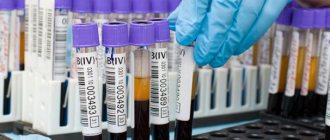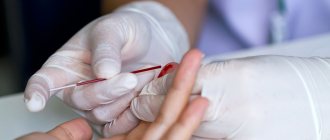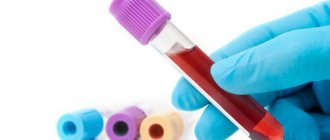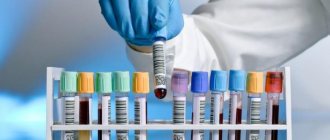Immunoglobulins are compounds that are produced by cells of the human body's immune system. They serve as protection against a variety of viruses, bacteria and other antigens. Immunoglobulins, which protect the human body, are widely used in the medical field for diagnostic purposes.
The use of qualitative and quantitative determinations of antibodies of various classes is necessary to identify many diseases, therefore, as part of the examination, patients are often recommended to take an immunoglobulin test. Immunoglobulins are also included in medications whose action is aimed at the prevention and treatment of infectious pathologies.
It is recommended to donate blood for immunoglobulin in order to identify certain pathologies in the body. A blood test for immunoglobulin is an examination of the immune system, which allows one to assess the patient’s condition and the severity of the disease, and, therefore, prescribe the correct treatment.
You can carry out high-quality diagnostics and treatment of any disease in one of the modern medical centers in Moscow - the Yusupov Hospital. The clinic’s latest equipment provides the most reliable research results, thanks to which our specialists have the opportunity to establish an accurate diagnosis and select a treatment regimen using advanced techniques
Types of immunoglobulins
Depending on the structure and function, immunoglobulins are divided into five main classes: G, M, E, A and D.
Immunoglobulin G(IgG)
This type of immunoglobulins constitutes the main class. It is found in blood serum and, in turn, is divided into four subclasses (IgG1, IgG2, IgG3, IgG4), each of which has its own unique functions. The production of immunoglobulin G occurs a few days after the production of immunoglobulin M, after which it remains in the body for a long period of time. Thanks to its anti-infective and anti-parasitic properties, immunoglobulin G ensures the elimination of infections, all kinds of viruses and fungi.
Immunoglobulin M (IgM)
The production of immunoglobulin M in the human body begins immediately after foreign agents enter it. These antibodies are called “alarming”. At the beginning of the development of any disease, there is a rapid increase in their number. The main task of immunoglobulins M is to provide the body’s initial defense when infections occur.
Immunoglobulin E (IgE)
Immunoglobulins E are specific antibodies, the appearance of which can be caused by an atopic type of allergy or worms. As a rule, normal immunoglobulin E is almost not observed in the blood.
Immunoglobulin A (IgA)
These antibodies help form local immunity of the mucous membranes. Immunoglobulins A are activated during the development of acute respiratory diseases and skin infections. Indicators of this type of immunoglobulin are increased in people suffering from alcoholism, chronic liver disease, and also in cases of poisoning.
Immunoglobulin D (IgD)
Immunoglobulin D (IgD) are antibodies with poorly understood functions to date. Most often they are part of medications.
IgG antibodies
The main role of IgG antibodies is the long-term protection of the body from most bacteria and viruses - although their production occurs more slowly, the response to an antigenic stimulus remains more stable than that of IgM class antibodies.
Levels of IgG antibodies rise more slowly (15-20 days after the onset of illness) than IgM antibodies, but remain elevated longer, so they may indicate a long-standing infection in the absence of IgM antibodies. IgG may remain at low levels for many years, but upon repeated exposure to the same antigen, IgG antibody levels rise rapidly.
For a complete diagnostic picture, it is necessary to determine IgA and IgG antibodies simultaneously. If the IgA result is unclear, confirmation is carried out by determining IgM. In case of a positive result and for an accurate diagnosis, a second test, done 8-14 days after the first, should be checked in parallel to determine the increase in IgG concentration. The results of the analysis must be interpreted in conjunction with information obtained in other diagnostic procedures.
IgG antibodies, in particular, are used to diagnose Helicobacter pylori, one of the causes of ulcers and gastritis.
In what cases is it necessary to take an immunoglobulin test?
It is necessary for patients to donate blood for immunoglobulin if they suspect the presence of the following diseases in the body:
- helminthiasis;
- hay fever;
- bronchial asthma;
- atopic dermatitis;
- eczema;
- food allergies;
- drug allergies;
- protracted, chronic and often recurrent infections;
- autoimmune or oncological pathologies;
- immunodeficiency.
In addition, a blood test for immunoglobulin is prescribed as part of a comprehensive examination before surgical interventions and during a difficult rehabilitation period after them.
Expert opinion
Author: Alexey Sergeevich Smychkov
Functional diagnostics doctor, candidate of medical sciences
With an allergy, the body responds to interaction with an antigen that is not inherently dangerous. Antibodies (or, as they are also called, immunoglobulins) are responsible for the development of this allergic reaction. Blood tests are carried out exclusively as prescribed by a doctor. It is important to know how to take an immunoglobulin test. You need to donate blood on an empty stomach. It is recommended to avoid emotional experiences and physical stress. The material is taken from a vein.
The level of immunoglobulin is determined using immunofluorescence analysis (ELISA). An antigen is added to the blood and the antibody content is determined depending on the color intensity. Only a doctor can correctly decipher the result. At the Yusupov Hospital, they accurately determine the diagnosis and prescribe the most effective complex therapy. It is important to take into account not only the indicators, but also the general condition of the patient. The doctor should also take into account information from other studies. It is these components that allow you to get an accurate picture of the disease and prescribe appropriate treatment.
Allergen-specific and general IgE
The ratio of allergen-specific immunoglobulin E (IgE) to total IgE has been called “specific activity.” Its utility has been studied in diagnosing several allergic disorders and predicting individual response to monoclonal antibody therapy (omalizumab). One study found that specific activity is no more useful than allergen-specific IgE alone in diagnosing food allergies. However, in the treatment of asthma with omalizumab, specific activity exceeding 3-4% predicted a decrease in response to omalizumab therapy. The ratio of allergen-specific IgE to total IgE remains primarily a clinical research tool; its overall practical utility has not yet been established.
Function of immunoglobulin E in the body
Immunoglobulin E is a specific indicator of allergies. Allergens that penetrate or come into contact with tissues interact with immunoglobulins of this type, as a result of which they bind into complexes, and the following allergic reactions occur at the sites of exposure:
- there is a runny nose, frequent sneezing, and increased sensitivity of the nasal mucosa (rhinitis);
- the shape and color of the skin changes (allergic rash);
- due to inflammation of the bronchi, a cough occurs (bronchitis);
- as a result of a decrease in the lumen of the bronchi, wheezing, difficulty breathing, shortness of breath (asthma) are noted;
- the development of an immediate allergic reaction to an irritant, often resulting in death (anaphylactic shock).
In terms of their structure, immunoglobulins E belong to gamma globulins, the production of which is responsible for B lymphocytes. They play a leading role in the development of atopic diseases: urticaria, allergic rhinitis, atopic dermatitis, bronchial asthma. In addition, class E immunoglobulins form an antiparasitic immune response to roundworms, toxoplasma, trichinella, echinococcus, nematodes and other types of parasites.
Normally, immunoglobulin E is contained in blood serum in small quantities (30-240 µg/l). The highest antibody levels are observed in late spring, and the lowest in early winter. Due to the active flowering of most plants, in May the air is saturated with pollen, which is a very strong allergen.
Immunoglobulins E appear in the human body during prenatal development. From birth to adolescence, there is a gradual increase in their level. A decrease in the amount of immunoglobulin E is observed in older people. Sharp fluctuations in the level of immunoglobulin E may indicate certain diseases.
A blood test for total immunoglobulin is usually prescribed for people suffering from bronchial asthma, atopic dermatitis, hay fever and helminthiasis. It is recommended to donate blood for immunoglobulin in order to identify drug and food allergies and possible hereditary diseases.
Make an appointment
Different levels of IgE in allergies
A total serum IgE level of 100 international units/mL (IU/mL) is generally considered the upper limit of normal for older adolescents and adults. Elevated levels of total serum IgE are observed in several types of diseases, including allergic diseases, some primary immunodeficiencies, parasitic and viral infections, some inflammatory diseases, some malignancies and a number of other diseases. Thus, elevated total serum IgE is not specific for allergic disease.
Increased level of total serum IgE.
Many patients with allergic disorders have elevated total IgE levels, but there is no defined cutoff value that distinguishes patients with allergic disease from those without. Total IgE alone is rarely sufficient to diagnose an allergic disease. The following studies are illustrative:
- Adults with IgE >66 IU/mL have a 37-fold greater risk of developing allergen-specific IgE antibodies to aeroallergens compared with patients with the lowest total IgE levels.
- In one study, school-age children had a mean IgE level of 51 IU/mL. In children with atopic dermatitis and asthma, the average IgE level was 985 IU/ml; those with asthma only, 305 IU/ml; patients with eczema only - 273 IU/ml, and patients with allergic rhinitis - 171 IU/ml.
- Among atopic patients of all ages, IgE levels are highest in patients with atopic dermatitis, followed by atopic asthma, chronic allergic rhinitis, and seasonal allergic rhinitis.
- Using a total serum IgE level of 100 IU/mL, the sensitivity was 78% for patients with asthma and 60% for rhinitis to distinguish allergic from nonallergic patients. 20% of patients were incorrectly classified.
Decreased or normal levels of total IgE.
Low levels of total serum IgE cannot be used to rule out the presence of atopic disease due to the significant overlap in total serum IgE between atopic and nonatopic populations. Patients with low or normal serum IgE levels may still have local tissue production of allergen-specific IgE.
Why is a blood test for immunoglobulin E prescribed?
Allergies are widespread throughout the world. It affects people of all professions, ages and social groups. Allergic diseases bring patients a lot of suffering and discomfort, causing a decrease in a person’s quality of life and numerous restrictions in food and everyday life. Often, the symptoms of allergies are similar to the manifestations of other diseases, so in order to select the most effective treatment, it is necessary to find out the true nature of the pathology.
An immunoglobulin E test is one of the most common tests performed to identify allergies. In addition, with the help of this test, the doctor can monitor the effectiveness of the therapy, predict relapses of the disease and evaluate the patient’s immune system in general.
A blood test for immunoglobulin E is carried out not only to determine its level, but also to identify allergens that provoked an allergic reaction in the body. To determine immunoglobulin E antibodies, tests are carried out using various groups of allergens: household (dust, dust mites), pollen, fungal, food, epidermal (particles of animal fur and skin).
There are currently no special medications that can reduce immunoglobulin levels. Its concentration gradually decreases by itself, after stopping the allergic reaction and carrying out full antiallergic therapy.
IgE level measurement
Total IgE.
Levels of total immunoglobulin E (IgE) are often measured using a sandwich assay. In this method, an anti-IgE antibody binds to a solid support. The patient's serum is added and then the unbound protein is washed away. A second labeled anti-IgE antibody is added and the amount bound to the patient's IgE is measured. Total serum IgE levels are expressed in international units or nanograms per milliliter (1 IU/mL = 2.44 ng/mL). IgE tests are calibrated against the World Health Organization's third International IgE Reference Preparation (WHO IgE-IRP).
Allergen-specific IgE.
The first commercial test for allergen-specific IgE was the radioallergosorbent test (RAST). Bound allergen-specific IgE was detected using radioiodine and quantified using a gamma counter. The term "RAST" is still often used to refer to in vitro tests for allergen-specific IgE, although modern methods use enzymes instead of radionucleotides. A number of other technical advances in assay technology have dramatically increased the sensitivity and specificity of allergen-specific IgE measurements. The terms “in vitro IgE antibody assay” or “allergen-specific IgE immunoassay” more accurately characterize the test options that are most common in the world:
- HYTEC-288 is a colorimetric assay using a solid phase support on a paper disk. It is increasingly being replaced by the Falcon laboratory automaton.
- ImmunoCAP is a fluorinated immunoassay with a solid-phase cellulose sponge matrix.
- The Immulite chemiluminescent assay contains a biotinylated allergen and a solid phase of avidin particles.
The lower limit of detection of allergen-specific IgE is lower than that of total IgE. Most laboratories use a lower limit of approximately 0.1 to 0.35 IU/mL.
Reasons for increased immunoglobulin E levels
An increase in the level of immunoglobulin of this class is observed in persons suffering from the following pathologies:
- allergic diseases (allergic conjunctivitis, sinusitis, rhinitis, anaphylaxis, atopic dermatitis, atopic bronchial asthma, urticaria, pollen, food, drug allergies, angioedema, allergic gastroenteropathy, etc.);
- parasitic infestations (echinococcosis, amoebiasis, ascariasis, nematode, hookworm, etc.);
- bronchopulmonary aspergillosis;
- immune diseases (Job syndrome, Wiskott-Aldrich syndrome, recurrent pyoderma, DiGeorge syndrome (thymic aplasia), periarteritis nodosa, Neumann syndrome, hypereosinophilia of unknown origin;
- infectious mononucleosis;
- selective deficiency of immunoglobulin A;
- liver cirrhosis of alcoholic origin.
Blood test for immunoglobulin E: diagnostic value
A blood test for immunoglobulin E allows the specialist to:
- assess the risk of developing allergic reactions in children (immunoglobulin value is a prognostic indicator);
- assess the overall immune status of the body;
- diagnose helminthic infestations;
- differentiate hypersensitivity reactions from diseases that have similar symptoms (chronic rhinitis, dermatitis, other diseases of the upper respiratory tract);
- evaluate the effectiveness of therapy for allergic diseases and other pathologies;
- objectively assess sensitization to a particular allergen.
Thus, an analysis for immunoglobulin E (hemotest and other blood tests) can be prescribed to patients if they are suspected of having allergic diseases (primarily atopic), immunodeficiency conditions, autoimmune diseases, helminthic infestation, bronchopulmonary aspergillosis, etc.
What type of hypersensitivity to allergens is the most dangerous?
As Kuzma Prutkov said: “Look at the root.” And in this situation, the root of the pathogenesis of allergic reactions will be the release of an increased amount of cellular mediators, those that will already realize the clinical picture of the allergy. And in this situation, only a doctor can help you figure it out. What type of allergic reaction are you experiencing? Because the approaches to the management and treatment of such patients will be completely different, and to diagnosis too. Each type of hypersensitivity has its own pathogenesis. The only thing is that in the implementation of hypersensitivity of the first type, allergens such as protein and pollen most often play an important role, and the same seasonal fever can be associated specifically with hypersensitivity of the first type. Also, some drugs, organic, inorganic, and chemical substances can cause anaphylactic reactions or type 1 hypersensitivity.
Why do I want to dwell in more detail on type 1 hypersensitivity? Because, from the point of view of a threat to human life, type 1 hypersensitivity can develop in a split second. It is more important and more dangerous, therefore, in order to correctly find out what kind of hypersensitivity you have, how to correctly approach certain aspects of treatment, of course, it is best, in this situation, to consult a doctor, a specialist who would definitely tell you established a diagnosis and selected the right treatment for you. And I categorically do not recommend self-medication.
Blood test for immunoglobulin E: how to take it correctly
A blood test for total immunoglobulin E is a special laboratory test of blood serum. For maximum reliability of the results, proper preparation is necessary:
- blood for testing is taken in the morning; 10-14 hours before the test, patients are advised not to eat; they can drink purified, still water;
- You must stop eating fatty and spicy foods, alcoholic beverages and smoking at least 24 hours in advance;
- It is recommended to exclude physical activity;
- If you are taking any medications, after consulting your doctor, to ensure the reliability of the test results, their use is usually discontinued.
A blood test for immunoglobulin E is not performed if the following contraindications are present:
- menstruation (test 3 days before or 5 days after menstruation);
- acute phase of an infectious disease (influenza, acute respiratory viral infection);
- taking antibiotics (blood can be donated 7-10 days after stopping antibacterial drugs).
Two days before donating blood to determine the level of immunoglobulin E, it is recommended to stop drinking alcohol, vitamins, dietary supplements, aspirin, and antihistamines. The patient coordinates the intake of vital medications with the attending physician. It is not recommended to conduct the study while taking cytostatics, glucocorticoids, radiation treatment and chemotherapy, as they inhibit the synthesis of immunoglobulins.
Why take antibody tests?
New methods of examination make all those who suffered from suspicious ARVI and bronchitis in the fall and winter want to get tested and answer the main question: is there immunity to SARS-CoV-2? Antibody testing can also help in making a decision about the possibility of returning people from the quarantine regime to public life.
For the initial antibody test, it is recommended to detect both IgM and IgG antibodies in the blood. Thus, the study indicates a current or recent infection.
How to decipher a blood test for total immunoglobulin E
The following indicators are considered reference values for immunoglobulin E in children:
- 0-3 months: from 0 to 2 kU/l;
- 3-6 months: from 3 to 10 kU/l;
- 6-12 months: from 8 to 20 kU/l;
- 1-5 years: from 10 to 50 kU/l;
- 5-15 years: from 16 to 60 kU/l.
Normal levels of immunoglobulin E in adults can range from 20 to 100 kE/l.
Deviation from the above norms, revealed during a blood test for total immunoglobulin E in individuals of both childhood and adulthood, may indicate the presence of a particular disease in the body or the development of a pathological process in it. In this case, the patient is prescribed additional examinations, during which it is established what is causing the disorder.










